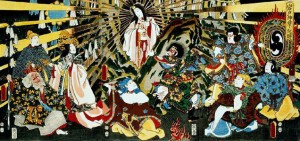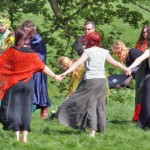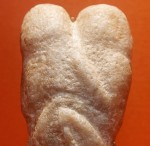
The Sun is hot and fiery and bright, so people associate it with maleness, the active/penetrative principle, yang, warriors, and intellect. The Moon is cool and reflective and represents intuition and dreams, so people associate it with the feminine, dreamy, receptive, and watery side of things.
We then go on to ascribe these qualities to actual men and women, or regard them as the “ideal” masculine and feminine qualities.
Of course we know that real Moon goddesses are not dreamy, pretty, airy-fairy, and harmless at all. But that doesn’t stop people from depicting them that way. And that real Sun gods have a sensitive and emotional side. Don’t we?
We tend to associate Summer Solstice with the Sun being at the height of its power, and it is at this time of year that a lot of archetypal material about the Sun god gets wheeled out for presentation at Pagan rituals.
But it doesn’t have to be that way!
!["Diana Reposing", by Paul-Jacques-Aimé Baudry [Public domain], Walters Collection, via Wikimedia Commons](https://wp-media.patheos.com/blogs/sites/311/2015/06/Paul-Jacques-Aim%C3%A9_Baudry_-_Diana_Reposing_-_Walters_3712-300x176.jpg)
Moon gods
In Hinduism, there is Chandra. The Mesopotamians worshipped the Moon god Sin. The Germanic tribes worshipped Mani. The Japanese worshipped Tsukuyomi. These cultures often featured female Sun goddesses.
According to Wikipedia,
the original Proto-Indo-European lunar deity appears to have been a male god. In subsequent traditions, the number of male moon deities (or words for “moon” with a male gender) seem to vastly outnumber female ones, which appear to be an exclusively eastern Mediterranean invention. Several goddesses, like Hecate or Artemis, did not originally have lunar aspects, and only acquired them late in antiquity, due to syncretism with Selene/Luna, the de facto Greco-Latin lunar deity. In traditions with male gods, there is little evidence of such syncretism, though the Greco-Roman Hermes has been equated with male Egyptian lunar gods like Thoth. In Greece proper, remnants of male moon gods are also seen with Menelaus.
Sun goddesses
Practitioners of Dievturība, the revived traditional religion of Latvia, celebrate the Sun goddess, Saulė. Saulė is a goddess with a fairly detailed story and attributes. She is the goddess of life, fertility, warmth, and health, and is patroness of the unfortunate, especially orphans. The Lithuanian and Latvian words for “the world” (pasaulis and pasaule) mean as “[a place] under the Sun”. The summer solstice is the feast of Saulė, and the winter solstice is celebrated as her return.
Amaterasu is the Japanese sun goddess, who is seen as the goddess of the sun and of the universe. The name Amaterasu derived from Amateru meaning “shining in heaven.” Her full name, Amaterasu-ōmikami, means “the great august kami (god) who shines in the heaven”. She hid in a cave after her brother Susa-no-o went on a rampage.

In Ancient Egypt, the earliest deities associated with the sun were all goddesses: Wadjet, Sekhmet, Hathor, Nut, Bast, Bat, and Menhit. There were also Moon gods, such as Thoth and Khonsu.
Ancient Heathens worshipped Sol and Mani. Sol was the goddess of the Sun, and her brother Mani was the goddess of the Moon. The horse’s of Sol’s chariot are called Árvakr (“Early Riser”) and Alsviðr (“Swift”). They are pursued across the sky by a wolf called Sköll, and the Moon is pursued by her brother Hati.
Dan McCoy writes:
According to one of the poems in the Poetic Edda, a figure named Svalinn rides in the sun’s chariot and holds a shield between her and the earth below. If he didn’t do this, both the land and the sea would be consumed in flames. Elsewhere, the father of Sol and Mani is named as “Mundilfari,” about whom we know nothing. His name might mean “The One Who Moves According to Particular Times.”
In runic lore, the gentle warmth of Sol is contrasted with the heat of the rune Sowelu, but it seems as if this might be a misattribution.
Deities in ritual
When I am writing rituals, I try not to always go for the “obvious”. I like to challenge people’s assumptions, and introduce deities that look a bit different. One year, I wrote a ritual to Saulė. Another summer solstice, I wrote a ritual all about the arrival of Parsifal at the Grail Castle.
It’s also a good idea to work with a deity you have some sort of connection with, or to try to establish a connection with the deity you are working with before the ritual. There’s nothing worse than a ritual falling flat because you didn’t make a connection with the deity. What does the deity’s story mean for you personally? How does it link in with the festival you are celebrating?
If the deity is not very well-known, I find out as much as I can about them, and email all the ritual participants their story beforehand, and/or build in a meditation about that deity.
Summer solstice
At this time of the year, the days are at their longest, so the Sun is said to be at the height of its power. However, after Midsummer, the days will get shorter, so the Sun is said (symbolically) to descend into the underworld. The Sun is a metaphor for consciousness; as we descend into the depths of winter, the self is said to go inward and become more introspective.
Whilst the summer solstice is the moment at which the days get shorter, and the Sun starts rising further south again, there is still plenty of summer left after the solstice. Some people regard 21 June as Midsummer, others regard it as the start of summer.
Summer is always associated with warmth and plenty and long lazy sunny days – until you get to the harvest, when it’s all hands to fields to bring in the crop before a summer rainstorm comes and trashes it.
The word solstice literally means “Sun stands still” as the Sun seems to rise at the same point on the horizon for a few days. So the solstice is a moment to pause, and take stock, as well as to enjoy the longest day.












